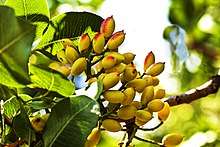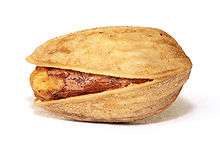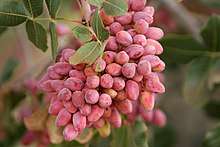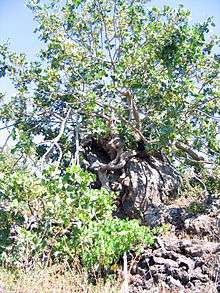Pistachio
The pistachio (/pɪˈstɑːʃiˌoʊ, -ˈstæ-/,[2] Pistacia vera), a member of the cashew family, is a small tree originating from Central Asia and the Middle East. The tree produces seeds that are widely consumed as food.
| Pistacia vera | |
|---|---|
 | |
| Pistacia vera (Kerman cultivar) fruits ripening | |
 | |
| Roasted pistachio seed with shell | |
| Scientific classification | |
| Kingdom: | Plantae |
| Clade: | Tracheophytes |
| Clade: | Angiosperms |
| Clade: | Eudicots |
| Clade: | Rosids |
| Order: | Sapindales |
| Family: | Anacardiaceae |
| Genus: | Pistacia |
| Species: | P. vera |
| Binomial name | |
| Pistacia vera | |
Pistacia vera often is confused with other species in the genus Pistacia that are also known as pistachio. These other species can be distinguished by their geographic distributions (in the wild) and their seeds which are much smaller and have a soft shell.
As of 2017, Iran accounted for over half the world's production of pistachios.
Etymology
Pistachio is from late Middle English "pistace", from Old French, superseded in the 16th century by forms from Italian "pistacchio", via Latin from Greek "pistakion", from Middle Persian "*pistak" (the New Persian variant being "pista").[3]
History
The pistachio tree is native to regions of Central Asia, including present-day Iran and Afghanistan.[4][5][6] Archaeology shows that pistachio seeds were a common food as early as 6750 BCE.[7] The modern pistachio P. vera was first cultivated in Bronze Age Central Asia, where the earliest example is from Djarkutan, modern Uzbekistan.[8][9]
It appears in Dioscorides' writings as pistakia (πιστάκια), recognizable as P. vera by its comparison to pine nuts.[10] Pliny the Elder writes in his Natural History that pistacia, "well known among us", was one of the trees unique to Syria, and that the seed was introduced into Italy by the Roman Proconsul in Syria, Lucius Vitellius the Elder (in office in 35 CE) and into Hispania at the same time by Flaccus Pompeius.[11] The early sixth-century manuscript De observatione ciborum ("On the observance of foods") by Anthimus implies that pistacia remained well known in Europe in Late Antiquity. Archaeologists have found evidence from excavations at Jarmo in northeastern Iraq for the consumption of Atlantic pistachio.[7] The Hanging Gardens of Babylon were said to have contained pistachio trees during the reign of King Merodach-Baladan about 700 BCE.[7]
In the 19th century, the pistachio was cultivated commercially in parts of the English-speaking world, such as Australia along with New Mexico[12] and California where it was introduced in 1854 as a garden tree.[13] In 1904 and 1905, David Fairchild of the United States Department of Agriculture introduced hardier cultivars to California collected from China, but it was not promoted as a commercial crop until 1929.[12][14] Walter T. Swingle's pistachios from Syria had already fruited well at Niles, California, by 1917.[15]
Botany

Habitat
Pistachio is a desert plant and is highly tolerant of saline soil. It has been reported to grow well when irrigated with water having 3,000–4,000 ppm of soluble salts.[12] Pistachio trees are fairly hardy in the right conditions and can survive temperatures ranging between −10 °C (14 °F) in winter and 48 °C (118 °F) in summer. They need a sunny position and well-drained soil. Pistachio trees do poorly in conditions of high humidity and are susceptible to root rot in winter if they get too much water and the soil is not sufficiently free-draining. Long, hot summers are required for proper ripening of the fruit.
Characteristics
The tree grows up to 10 m (33 ft) tall. It has deciduous pinnate leaves 10–20 centimeters (4–8 inches) long. The plants are dioecious, with separate male and female trees. The flowers are apetalous and unisexual and borne in panicles.


The fruit is a drupe, containing an elongated seed, which is the edible portion. The seed, commonly thought of as a nut, is a culinary nut, not a botanical nut. The fruit has a hard, cream-colored exterior shell. The seed has a mauve-colored skin and light green flesh, with a distinctive flavor. When the fruit ripens, the shell changes from green to an autumnal yellow/red and abruptly splits partly open. This is known as dehiscence, and happens with an audible pop. The splitting open is a trait that has been selected by humans.[16] Commercial cultivars vary in how consistently they split open.
Each pistachio tree averages around 50 kilograms (110 lb) of seeds, or around 50,000, every two years.[17]
The shell of the pistachio is naturally a beige color, but it is sometimes dyed red or green in commercial pistachios. Originally, dye was applied by importers to hide stains on the shells caused when the seeds were picked by hand.[18] Most pistachios are now picked by machine and the shells remain unstained, making dyeing unnecessary except to meet ingrained consumer expectations.
Cultivation

The pistachio tree is long-lived, possibly up to 300 years.[19] The trees are planted in orchards, and take approximately seven to ten years to reach significant production. Production is alternate-bearing or biennial-bearing, meaning the harvest is heavier in alternate years. Peak production is reached around 20 years. Trees are usually pruned to size to make the harvest easier. One male tree produces enough pollen for eight to twelve drupe-bearing females. Harvesting in the United States and in Greece is often accomplished using equipment to shake the drupes off the tree. After hulling and drying, pistachios are sorted according to open-mouth and closed-mouth shells, then roasted or processed by special machines to produce pistachio kernels.
In California, almost all female pistachio trees are the cultivar 'Kerman'. A scion from a mature female 'Kerman' is grafted onto a one-year-old rootstock.
Diseases and environment
Pistachio trees are vulnerable to numerous diseases and infection by insects such as Leptoglossus clypealis.[20] Among these is infection by the fungus Botryosphaeria, which causes panicle and shoot blight (symptoms include death of the flowers and young shoots), and can damage entire pistachio orchards.[21] In 2004, the rapidly growing pistachio industry in California was threatened by panicle and shoot blight first discovered in 1984.[22] In 2011, anthracnose fungus caused a sudden 50% loss in the Australian pistachio harvest.[23] Several years of severe drought in Iran around 2008 to 2015 caused significant declines in production.[24]
Production
| Pistachio production, 2018 | |||
|---|---|---|---|
| Source: FAOSTAT of the United Nations[25] | |||
In 2018, the global production of pistachios was about 1.4 million tonnes, with Iran and the United States as leading producers, together accounting for 72% of the total (table). Secondary producers were Turkey, China, and Syria.[25]
A 2020 report indicated that nearly half of the global production of pistachios in 2019 came from the United States, with production in Iran falling to as low as 7% due to US trade sanctions against Iran, climate change, and weak economic and water management in Iran.[26] Efforts to grow pistachios for international markets were made during 2019 in Georgia and adjacent Caucasus countries.[26]
Consumption

The kernels are often eaten whole, either fresh or roasted and salted, and are also used in pistachio ice cream, kulfi, spumoni, pistachio butter,[27][28] pistachio paste[29] and confections such as baklava, pistachio chocolate,[30] pistachio halva,[31] pistachio lokum or biscotti and cold cuts such as mortadella. Americans make pistachio salad, which includes fresh pistachios or pistachio pudding, whipped cream, and canned fruit.[32]
Nutrition
| Nutritional value per 100 g (3.5 oz) | |
|---|---|
| Energy | 2,351 kJ (562 kcal) |
27.51 g | |
| Sugars | 7.66 g |
| Dietary fiber | 10.3 g |
45.39 g | |
| Saturated | 5.556 g |
| Monounsaturated | 23.820 g |
| Polyunsaturated | 13.744 g |
20.27 g | |
| Vitamins | Quantity %DV† |
| Vitamin A equiv. | 1205 μg |
| Thiamine (B1) | 76% 0.87 mg |
| Riboflavin (B2) | 13% 0.160 mg |
| Niacin (B3) | 9% 1.300 mg |
| Pantothenic acid (B5) | 10% 0.52 mg |
| Vitamin B6 | 131% 1.700 mg |
| Folate (B9) | 13% 51 μg |
| Vitamin C | 7% 5.6 mg |
| Vitamin D | 0% 0 μg |
| Vitamin E | 15% 2.3 mg |
| Vitamin K | 13% 13.2 μg |
| Minerals | Quantity %DV† |
| Calcium | 11% 105 mg |
| Iron | 30% 3.92 mg |
| Magnesium | 34% 121 mg |
| Manganese | 57% 1.2 mg |
| Phosphorus | 70% 490 mg |
| Potassium | 22% 1025 mg |
| Zinc | 23% 2.2 mg |
| Other constituents | Quantity |
| Water | 4 g |
| |
| †Percentages are roughly approximated using US recommendations for adults. Source: USDA Nutrient Database | |
Raw pistachios are 4% water, 45% fat, 28% carbohydrates, and 20% protein (table). In a 100 gram reference amount, pistachios provide 562 calories and are a rich source (20% or more of the Daily Value or DV) of protein, dietary fiber, several dietary minerals, and the B vitamins, thiamin (76% DV) and vitamin B6 (131% DV) (table).[33] Pistachios are a moderate source (10–19% DV) of calcium, riboflavin, vitamin B5, folate, vitamin E, and vitamin K (table).
The fat profile of raw pistachios consists of saturated fats, monounsaturated fats and polyunsaturated fats.[33][34] Saturated fatty acids include palmitic acid (10% of total) and stearic acid (2%).[34] Oleic acid is the most common monounsaturated fatty acid (51% of total fat)[34] and linoleic acid, a polyunsaturated fatty acid, is 31% of total fat.[33] Relative to other tree nuts, pistachios have a lower amount of fat and calories but higher amounts of potassium, vitamin K, γ-tocopherol, and certain phytochemicals such as carotenoids, and phytosterols.[35][36]
Research and health effects
In July 2003, the United States Food and Drug Administration approved the first qualified health claim specific to consumption of seeds (including pistachios) to lower the risk of heart disease: "Scientific evidence suggests but does not prove that eating 1.5 ounces (42.5 g) per day of most nuts, such as pistachios, as part of a diet low in saturated fat and cholesterol may reduce the risk of heart disease".[37] Although a typical serving of pistachios supplies substantial calories (nutrition table), their consumption in normal amounts is not associated with weight gain or obesity.[35]
Pistachio consumption appears to modestly lower systolic and diastolic blood pressure in persons without diabetes mellitus.[38]
Toxin and safety concerns
As with other tree seeds, aflatoxin is found in poorly harvested or processed pistachios. Aflatoxins are potent carcinogenic chemicals produced by molds such as Aspergillus flavus and Aspergillus parasiticus. The mold contamination may occur from soil, poor storage, and spread by pests. High levels of mold growth typically appear as gray to black filament-like growth. It is unsafe to eat mold-infected and aflatoxin-contaminated pistachios.[39] Aflatoxin contamination is a frequent risk, particularly in warmer and humid environments. Food contaminated with aflatoxins has been found as the cause of frequent outbreaks of acute illnesses in parts of the world. In some cases, such as Kenya, this has led to several deaths.[40]
Pistachio shells typically split naturally prior to harvest, with a hull covering the intact seeds. The hull protects the kernel from invasion by molds and insects, but this hull protection can be damaged in the orchard by poor orchard management practices, by birds, or after harvest, which makes it much easier for pistachios to be exposed to contamination. Some pistachios undergo so-called "early split", wherein both the hull and the shell split. Damage or early splits can lead to aflatoxin contamination.[41] In some cases, a harvest may be treated to keep contamination below strict food safety thresholds; in other cases, an entire batch of pistachios must be destroyed because of aflatoxin contamination.
Like other members of the family Anacardiaceae (which includes poison ivy, sumac, mango, and cashew), pistachios contain urushiol, an irritant that can cause allergic reactions.[42]
Spontaneous combustion
The improper storage of pistachio products in bulk containers has been known to start fires. Because of their high fat and low water contents, the nuts and especially kernels are prone to self-heating and spontaneous combustion when stored with oil-soaked fiber or fibrous materials.[43][44]
See also
References
- Participants of the FFI/IUCN SSC Central Asian regional tree Red Listing workshop, Bishkek, Kyrgyzstan (11-13 July 2006) (2007). Pistacia vera. The IUCN Red List of Threatened Species 2007: e.T63497A12670823. doi:10.2305/IUCN.UK.2007.RLTS.T63497A12670823.en Downloaded on 05 January 2019.
- "Pistachio". Oxford Dictionaries UK Dictionary. Oxford University Press. Retrieved 25 February 2016.
- "Pistachio". Dictionary.com.
- "Pistacia vera L. | Plants of the World Online | Kew Science". Plants of the World Online. Retrieved 24 May 2019.
- "Pistachio | Description, Uses, & Nutrition". Encyclopedia Britannica. Retrieved 24 May 2019.
The pistachio tree is believed to be indigenous to Iran.
- V. Tavallali and M. Rahemi (2007). "Effects of Rootstock on Nutrient Acquisition by Leaf, Kernel and Quality of Pistachio (Pistacia vera L.)" (PDF). American-Eurasian J. Agric. & Environ. Sci., 2 (3): 240-246, 2007: 240.
- "History and Agriculture of the Pistachio Nut". IRECO. Archived from the original on 8 July 2006. Retrieved 27 February 2012.
- D. T. Potts (21 May 2012). A Companion to the Archaeology of the Ancient Near East, Volume 1. p. 199. ISBN 9781405189880.
- Harlan Walker (1996). Cooks and Other People. p. 84. ISBN 9780907325727.
- James Strong, ed. Cyclopaedia of Biblical, Theological, and Ecclesiastical Literature, s.v. "Nut".
- Pliny's Natural History, xiii.10.5, xv.22.
- Esteban Herrera (1997) Growing pistachios in New Mexico, New Mexico State University, Cooperative Extension Service, Circular 532
- Introduction to Fruit Crops (Published Online), Mark Rieger, Rieger asserts that pistachios began to be commercially harvested in the 1970s. 2006
- Fairchild, David (1938). The World Was My Garden. New York: Charles Scribner's Sons. p. 174. ISBN 0-686-84310-X.; Commissioner of Horticulture of the State of California,Biennial report1905/06, vol. II:392.
- Liberty Hyde Bailey, Cyclopedia of American Agriculture: II.Crops, 1917, s.v."Importance of plant introduction" p.
- Towards a comprehensive documentation and use of Pistacia genetic diversity in Central and West Asia, North Africa and Europe, Report of the IPGRI Workshop, 14–17 December 1998, Irbid, Jordan – S.Padulosi and A. Hadj-Hassan, editors
- Nugent, Jeff; Julia Boniface (30 March 2005). "Pistachio Nuts". Permaculture Plants: A Selection. Permanent Publications. p. 41. ISBN 978-1-85623-029-2.
- Spiegel, Alison (2 February 2015). "Remember Red Pistachios? Here's What Happened To Them". The Huffington Post. Retrieved 12 February 2017.
- "Pistachio cultivation (translated)". www.infoagro.com. 18 March 2019.
- Bolkan, Hasan (1 March 1984). "Leaf-footed bug implicated in pistachio epicarp lesion". California Agriculture. 38: 16–17.
- Parfitt, D.E.; Arjmand, N.; Michailides, T.J. (July 2003). "Resistance to Botryosphaeria dothidea in pistachio". HortScience. 38 (4): 529. doi:10.21273/HORTSCI.38.4.529.
- "California Pistachio Industry Threatened By Potentially Devastating Disease". ScienceDaily. 12 January 2004. Retrieved 9 March 2017.
- Keim, Brandon (26 April 2011). "Australia Pistachio Disaster Hints at Agricultural Breakdown". Wired Magazine-Science. Retrieved 9 March 2017.
- Erdbrink, Thomas (18 December 2015). "Scarred Riverbeds and Dead Pistachio Trees in a Parched Iran". New York Times. Retrieved 9 March 2017.
- "Pistachio production in 2018, Crops/Regions/World list/Production Quantity (pick lists)". UN Food and Agriculture Organization, Corporate Statistical Database (FAOSTAT). 2019. Retrieved 24 February 2020.
- Champion, Marc (21 February 2020). "The U.S.-Iran pistachio war is heating up". Bloomberg Businessweek. Retrieved 24 February 2020.
- Ardekani, A. S. H.; Shahedi, M.; Kabir, G. (2009). "Optimizing Formulation of Pistachio Butter Production" (PDF). Journal of Science and Technology of Agriculture and Natural Resources. 13 (47): 49–59. Archived from the original (PDF) on 19 August 2011.
- Ardakani; Shahedi, M.; Kabir, G. (2006). Optimizing of the process of pistachio butter production. Acta Horticulturae. 726. pp. 565–568.
- Shakerardekani, A.; Karim, R.; Mohd Ghazali, H.; Chin, N. L. (2011). "Effect of roasting conditions on hardness, moisture content and colour of pistachio kernels" (PDF). International Food Research Journal. 18: 704–710.
- Ardakani (2006). The vital role of pistachio processing industries in development of Iran non-oil exports. Acta Horticulturae. 726. pp. 579–581.
- Shaker Ardakai, A.; Mir Damadiha, F.; Salehi, F.; Shahedi, M.; Kabir, G. H.; Javan Shah, A.; et al. (2007). "Pistachio Halva Production". Document Number: 29328. Iran Pistachio Research Institute.
- "Pistachio Salad". RecipeSource. Retrieved 17 January 2011.
- "Pistachio nuts, raw per 100 g". Release SR-28. USDA National Nutrient Database. 2016. Retrieved 20 May 2016.
- Okay Y (2002). "The comparison of some pistachio cultivars regarding their fat, fatty acids and protein content". Die Gartenbauwissenschaft. 67 (3): 107–113. JSTOR 24137567.
- Bulló, M; Juanola-Falgarona, M; Hernández-Alonso, P; Salas-Salvadó, J (April 2015). "Nutrition attributes and health effects of pistachio nuts". The British Journal of Nutrition (Review). 113 (Supplement 2): S79-93. doi:10.1017/S0007114514003250. PMID 26148925.
- Dreher, ML (April 2012). "Pistachio nuts: composition and potential health benefits". Nutrition Reviews (Review). 70 (4): 234–40. doi:10.1111/j.1753-4887.2011.00467.x. PMID 22458696.
- Office of Nutritional Products, Labeling and Dietary Supplements (23 July 2003). "Qualified Health Claims: Letter of Enforcement Discretion – Nuts and Coronary Heart Disease (Docket No 02P-0505)". Center for Food Safety and Applied Nutrition. Archived from the original on 17 June 2008. Retrieved 17 June 2008.
- Mohammadifard, N; Salehi-Abargouei, A; Salas-Salvadó, J; Guasch-Ferré, M; Humphries, K; Sarrafzadegan, N (May 2015). "The effect of tree nut, peanut, and soy nut consumption on blood pressure: a systematic review and meta-analysis of randomized controlled clinical trials". The American Journal of Clinical Nutrition (Systematic Review & Meta-Analysis). 101 (5): 966–82. doi:10.3945/ajcn.114.091595. PMID 25809855.
- E. Boutrif (1998). "Prevention of aflatoxin in pistachios" (PDF). FAO, United Nations.
- "Aflatoxins in pistachios" (PDF). European Union. 2008.
- Doster and Michailides (1994). "Aspergillus Moulds and Aflatoxins in Pistachio Nuts in California". Phytopathology. 84 (6): 583–590. doi:10.1094/phyto-84-583.
- Mabberley, D. J. (1993). The Plant Book. Cambridge: Cambridge Univ. Press. p. 27. ISBN 0-521-34060-8.
- "Risk factor: self-heating/spontaneous combustion". Container Handbook. Gesamtverband Deutsche Versicherungswirtschaft. Retrieved 17 June 2008.
- "Pistachio Nuts: Self-heating". Transport Information Service. Gesamtverband Deutsche Versicherungswirtschaft. Retrieved 5 November 2007.
External links
| Wikimedia Commons has media related to Pistachio. |
| Look up pistachio in Wiktionary, the free dictionary. |
Chisholm, Hugh, ed. (1911). . Encyclopædia Britannica (11th ed.). Cambridge University Press.
